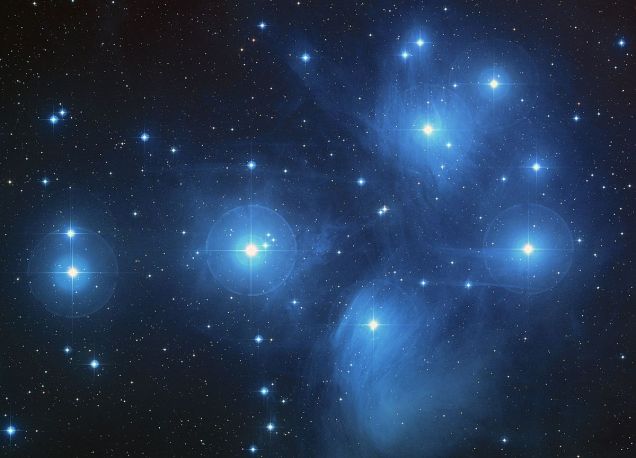Kua ara ake ahau i te papa o te whenua
Kua kite ahau i ngā whetū e tūtaki tahi ana
Ko Matariki te kairūri
Ko Atutahi kei te taumata o te mangōroaThe scope of our imagination is from the earth to the stars
Professor Te Wharehuia Milroy, Kura Reo ki Te Waipounamu 2014
Matariki 2017 is a fresh look through old eyes at Māori oral traditions, practices and customs associated with the Māori New Year. Over the next three years the Christchurch City Libraries will be re-introducing ‘Te Iwa o Matariki – the Nine stars of Matariki’ beginning with Te Kātao o Matariki – the water stars of Matariki, Waipuna-ā-rangi, Waitī, Waitā.

Nine or Seven? That is the question!
The star cluster of Matariki (Pleiades) has long been associated with the Greek tale of the seven daughters of Pleione and Altas, who, upon being harassed turned into doves and flew into the heavens. In this version of the story, two stars were not included in any traditions or commemorations, rather the mythical seven were embraced.
However history records that Māori were aware of the presence of more than seven visible stars within the cluster as noted by historian Elsdon Best in his 1955 book The Astronomical knowledge of the Māori:
“[Historian William] Colenso writes [in 1839 in the far north]: “I found that the Maori (sic) could see more stars in the Pleiades with the unaided eye than I could, for, while I could only see clearly six stars, they could see seven and sometimes eight.” (Best, 1922)
Associate Professor, Dr Rangi Matamua, Te Whare Wānanga o Waikato, is a leading Māori astronomer. He has spent over 20 years researching indigenous astronomy. Awarded the 2014 Fulbright Scholarship - Ngā Pae o te Māramatanga, Rangi used the grant to study how astronomy is embedded into the cultural practices of indigenous people. That same year he was successful in leading a group of Māori astronomers in securing funding from the Royal Society - Te Apārangi (the Marsden Fund) to continue this study. It is through his Ngā Pae o te Māramatanga research and the work of the Marsden Fund project Te Mauria Whiritoi that Rangi has re-confirmed that there are nine stars that constitute the star cluster of Pleiades or Matariki not just seven stars as commonly believed.
For this reason Rangi and Te Reo Māori Language expert, Paraone Gloyne produced an article in Mana Magazine reclaiming the two missing stars and providing an insight into Te Iwa o Matariki.
“Contrary to popular belief, there are nine stars in the constellation of Matariki, rather than seven. They all hold dominion over particular areas of our environment as seen from a Māori world view. They are; Matariki, Pōhutukawa, Waitī, Waitā, Waipuna-ā-rangi, Tupuānuku, Tupuārangi, Ururangi, and Hiwa-i-te-rangi. Traditionally, our ancestors did not just look at the constellation as a whole, but rather viewed each star individually, gaining an insight into the year ahead.” (Gloyne, Matamua, Mana, May 2016)
Puanga or not to Puanga?
For some iwi, Puanga not Matariki marks the start of the New Year as it rises just before Matariki. For others Puanga is seen as the pre-cursor to the rise of Matariki. It is Puanga that foretells the fortunes of the coming of the New Year by his appearance and placement when he first rises after the first new moon. It is Matariki who confirms it through her placement and appearance when she appears three days later.
According to some oral traditions, Puanga is the older brother of Takurua his younger brother, and his pretty younger sister Matariki. Jealous of the attention Matariki gets, “the task of Puanga is to strive ahead of Matariki that he may again take possession of the year for himself.” (Puanga, Star of the Māori New Year) It is for this reason he appears prior to Matariki in the hope that he may be heralded as the bringer of the New Year, only to be overlooked with the appearance of Matariki.
Does Matariki always rise in June?
No, the last quarter of the moon cycle known as the Tangaroa nights of the moon is when Matariki rises. This can vary from year to year but is always in the cold months from May to July. This year the rise of Matariki is from 17 to 20 June while the period of Matariki is from 17 to 24 June.
Further Reading
- Matariki – Māori New Year 2017 - Find out about this year's Matariki events
- Matariki resource list (with a focus on Te Kātao o Matariki – the water stars of Matariki)
- Explore our page on Matariki.
- Read our page on Matariki for kids.
- Find more information on Te Ao Māori and Te Ao Māori for tamariki.
This article was published in issue 4 of our quarterly magazine, uncover – huraina.



Add a comment to: Te Iwa o Matariki – The Nine Stars of Matariki